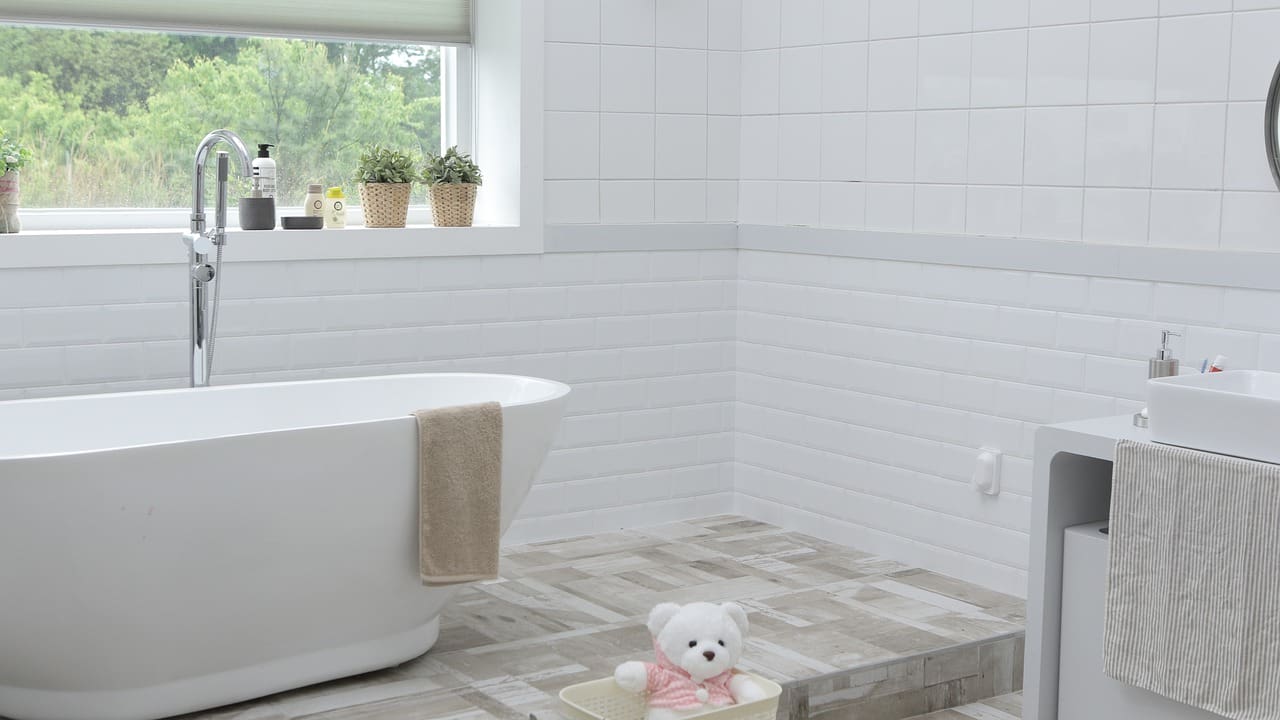There’s nothing more off-putting than black spots forming on the walls, the tiles or, horror of horrors, behind the toilet. Considering how to prevent mold in the bathroom should be at the forefront of every homeowner’s mind.
Understanding Mold And Mildew
Mold and Mildew thrive in damp conditions and a poorly ventilated bathroom is ideal for many of them. Not only are they unsightly and often a bit smelly, they can present health risks, especially to those who have allergies.
Mold Vs Mildew
To get technical for a moment, mildews are a specific sub-group of molds. Both are microscopic fungi that grow into multicellular filaments (called hyphae by biologists). We generally refer to them as different things based on a couple of defining features.
Molds are usually black, green or red, depending on the particular species, slightly ‘fuzzy’ and stand proud of the surface. Mildews are usually grey, flat, have a ‘powdery’ texture and can produce a distinctive musty smell.
Why Are Bathrooms Prone to Mold And Mildew Growth?
Molds and mildews thrive in damp conditions and, unfortunately for us, bathrooms often fit that bill.
Bathrooms are by nature damp environments. Hot running water, splashes from basins, showers and baths, damp towels- it all contributes to a humidity level that’s unlikely to be found elsewhere in the home. When this higher humidity is combined with insufficient ventilation it builds up on surfaces. This produces the ideal habitat for molds and mildews to take hold.
An unpleasant bonus feature for mold growth in the bathroom is the presence of the toilet. Flushing without lowering the lid sends tiny particles of whatever was in there around the room, offering nutrients to go with the humidity. It doesn’t bear thinking about!
Identifying Signs Of Mold And Mildew
Molds and mildews leave signs of their presence, both visible and invisible. Spotting these early reduces the impact and makes rectifying the problem much easier.
Visible Signs
- Spots: most often black though sometimes green or red
- Gray powders forming on surfaces and cloths
- Raised patches
Keep an eye out for any of these signs across tiles, in the grout between them, across ceilings and under sinks.
Non-visible Signs
- Odors: mildew in particular often has a distinctively ‘musty’ smell. That odor could also be an indicator of conditions which may lead to other fungal growths too.
- Health symptoms: Perhaps most seriously, but also most subtly, mold and mildew exposure can lead to serious health problems. Exposure to spores can exacerbate allergies, cause respiratory problems and even skin rashes. It’s not always obvious what might be causing these symptoms either.
Preventative Measures: Reducing Moisture and Humidity
The old adage is absolutely true: prevention is better than a cure. If you’re wondering how to prevent mold in your bathroom, the key is in making it as inhospitable as possible. Even through bathrooms are usually pretty humid spaces, there are a few things you can do to make this easy:
Improve Ventilation
Improving airflow through your bathroom is a great way to prevent mold in your bathroom. As air circulates, it takes evaporated moisture with it as well as any spores which might be building up. There are two simple ways to improve ventilation:
- Install an exhaust fan
- Keep windows and doors ajar
An exhaust or extractor fan will physically pull the air out, creating a flow. They’re best used during and just after your shower or bath. Likewise, having the window open slightly will allow air to circulate, diluting the humidity and reducing the risk of mold growth.
Dehumidifiers
It should come as no great surprise that dehumidifiers are a great way to reduce humidity in the bathroom. There are two types which can find a great home in any bathroom:
- Refrigerated units
- Desiccant units
You may be more familiar with refrigerated units in spaces like basements. They draw air through themselves and use a refrigerated surface to condense the moisture out.
Desiccant units may or may not be powered. Unpowered ones can be left sitting in problem spots, such as under the basin where they will absorb the moisture from the air. They work best in smaller, poorly ventilated spaces.
The main advantage of powered units is that they can be controlled, allowing you to set a desired level of humidity. However, they tend to be bulky and this means that they’re often unsuited to bathroom usage.
Regular Cleaning
When dealing with a humid environment like a bathroom, some mold is almost inevitable. Keeping on top of your cleaning routines will stop it from building up and causing serious problems down the line.
If you’re finding mold growing on shower tiles or mildew in the shower, there are a range of products that can help. There are specialist mold-remover products available in the cleaning supplies section of most stores, but baking soda and vinegar almost always works too.
Pay particular attention to grout, sealants (especially in corners) and around faucets and showerheads. These locations can often hold moisture and be tricky to reach with a cloth, making them prime real estate for fungal growth.
Keeping Surfaces Dry
It’s never a bad idea to ensure that water isn’t left standing on any surface in your bathroom. Wiping down tiles, shower walls, glass and mirrors will remove a prime source of moisture. Ensuring that these are all relatively dry after use will also reduce the amount of cleaning you need to do later- win/win!
Keep a squeegee in the shower or make use of a dry towel, or even better, a microfiber cloth and remove as much of the splashing and condensation as you can.
Repair Leaks
If you find something leaking, repair it as quickly as possible. Regularly inspect faucets, accessible pipework and showerheads for signs of leakage. Not only is this a good way to avoid mold and mildew forming in hidden spots, it avoids water damage to woodwork and floors too.
It’s not just pipes and faucets you should inspect regularly; check over sealants too. Small gaps can allow a surprising amount of water to escape over time.
Choosing Mold Resistant Materials
Unfortunately, no matter how good your moisture discipline is, spores are going to find their way into your bathroom. This is where mold-resistant materials come in; by denying mold an easy foothold, you can reduce the amount you have to deal with.
Particularly useful are:
- Paints
- Sealants and caulk
- Grout
- Specialist shower curtains
When re-doing your bathroom, look out for products which are specifically marketed as “anti-mold” or “mold-resistant”. Using these makes keeping on top of fungal growth much easier in the long-run.
Natural Remedies And Eco-Friendly Solutions
While there are certainly a lot of anti-mold treatments on the market, good old-fashioned home remedies are often just as good.
As with any cleaning blog, we’re going to recommend the old standard; baking soda and vinegar. The combination of acidity, gentle abrasiveness and fizzing action is great for all kinds of cleaning tasks, but is particularly effective on dealing with bathroom mold.
Simply mix the ingredients together and apply the resulting fizzy paste to problem areas. Leave it to work its magic then wash it off. Don’t forget to dry the surface when you’re done!
Essential Oils
Incorporating oils into your cleaning routine can help reduce mold growth without resorting to harsh chemicals. Tea tree is particularly effective but eucalyptus and lavender work wonders too. A small amount on a cloth, wiped over surfaces while you clean will help retard molds and mildews.
On top of their anti-fungal properties, they also leave your bathroom smelling absolutely great too.
Professional Help And Maintenance
Sometimes when you’re wondering how to prevent mold in your bathroom there’s no other practical option left but to call in the big guns.
Professional cleaners deal with these problems all the time and can help you deal with mild to moderate issues. In really extreme circumstances, you may need to hire a mold-mitigation expert.
Sometimes the cause of a mold infestation might not be immediately obvious. In these circumstances, it’s a good idea to book an inspection from a professional plumber. They will be able to tell if water is finding its way where it shouldn’t, even in harder to access areas.
Booking a regular cleaning and an annual plumbing inspection can help avoid mold and mildew ever getting a foothold. Both also make looking after your home that much easier, offering great peace of mind.
If you’re wondering how to prevent mold in your bathroom, the answer is simple. Keep it dry, keep it clean and keep on top of the maintenance routine. Follow our simple tips and those unpleasant odors, unsightly spots and all the associated risks can be a thing of the past.

